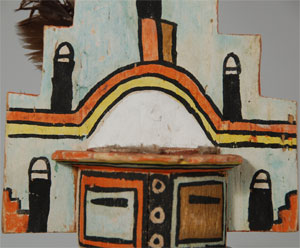Hopi Cottonwood Hemis Katsina Doll, circa 1930s [SOLD]
+ Add to my watchlist Forward to Friend
- Category: Traditional
- Origin: Hopi Pueblo, Hopituh Shi-nu-mu
- Medium: cottonwood root, feathers, paint
- Size: 14-7/8” tall
- Item # 25561 SOLD

The Hemis Katsina is probably the most beautiful and best known of all Hopi Katsinas. His elaborate headdress, called a tableta, is partly responsible for his beauty. His body is painted with black corn smut and sometimes with light colored half-moons on the chest and on both legs. He wears a kilt, and around his waist is a Hopi embroidered rain sash that hangs down the right side. The tableta is painted with phallic and cloud symbols and capped with feathers.
This katsina appears in the Home Dance or Niman Ceremony. No other katsinas, neither clowns nor side dancers appear with the line of Hemis except the Hemis Manas.
It is interesting to note that at Hopi, they refer to the Hemis Katsina as having come from the Rio Grande Jemez Pueblo of New Mexico. At Jemez Pueblo, they refer to a similar dance as a Hopi dance.
Condition: very good condition
Provenance: ex. museum collection. In the 1930s, a gentleman travelled extensively and purchased dolls for his daughter from throughout the world. The daughter displayed them in a private museum during the 1930-1941 periods. Just recently, the contents of the museum were sold at auction. This is one of the 16 katsina dolls in the museum.
Recommended Reading: Kachinas: A Hopi Artist's Documentary by Barton Wright
- Category: Traditional
- Origin: Hopi Pueblo, Hopituh Shi-nu-mu
- Medium: cottonwood root, feathers, paint
- Size: 14-7/8” tall
- Item # 25561 SOLD



